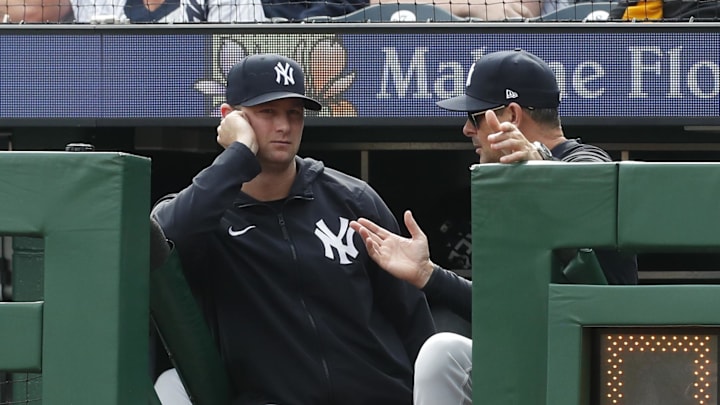When the American League MVP finalists are announced, one deserving candidate is almost certain to be ignored.
In 2023, New York Yankees star Gerrit Cole clearly ranked among the game’s elite talents. He had a 15-4 record, a league-leading ERA, and he pitched more innings (209) than anyone.
At +7.5, Cole had the second highest WAR of any American League player, trailing only two-way star Shohei Ohtani. His 4.6 Win Probability Added trailed only Ohtani (6.2) and Yordan Alvarez (4.7), the latter by the smallest fractional particle. Ohtani was also the only player to out-perform Cole in OPS+/ERA+, which is the park and era-normalized measurement of player exceptionality where 100 equals league average.
By all three of those widely accepted new-age yardsticks (WAR, Win Probability and OPS/ERA+), Cole clearly ranks among the AL elite for 2023 performance. If algorithms had a vote, he would finish a solid second behind Ohtani.
But he won’t because the voting is done by humans, and they have a clear, consistent bias … against pitchers.
Why New York Yankees ace Gerrit Cole will get snubbed in AL MVP voting
Not since 2014, when Clayton Kershaw won the National League version of the award, have voters allowed a pitcher to even stand among the three finalists. This despite the fact that pitchers frequently rank among the three greatest contributors to team success, as Cole does this just-concluded season.
Take last season as an example. Sandy Alcantara’s 7.8 WAR tied for second-highest in the National League, standing equal with Paul Goldschmidt and one-tenth of a point behind Nolan Arenado. His 5.4 Win Probability Added was seven-tenths of a point better than Goldschmidt, nine-tenths better than Manny Machado and 3.0 better than Arenado.
Alcantara’s 180 ERA+ topped Goldschmidt (177), Machado (157) and Arenado (151), the latter two by substantial margins.
Yet when the votes were tabulated, the award went to Goldschmidt, with Machado second and Arenado third. Alcantara? 10th place.
There can only be one reason — an anti-pitcher bias.
The argument will be that pitchers have their own award, the Cy Young (which, for the record, Alcantara won, as Cole will almost certainly win this season).
But if the existence of the Cy Young is a good reason to ignore pitching contributions when considering the MVP, then two questions must be addressed.
1. Why don’t the MVP rules exclude pitchers?
2. Is the term "value" in baseball defined only in a position-player sense?
Plainly pitchers are not excluded either by law or practice from the MVP balloting. The history of the ballot demonstrates this. In seven of the last eight seasons, at least one pitcher (sometimes two) has finished between fifth and 10th on his league’s MVP ballot. Alcantara and AL Cy Young winner Justin Verlander were 10th in their respective leagues last year,
They’re not excluded; they merely downgraded because they’re, well, pitchers. Voters punish them either because they don’t value the pitching component or (more likely) because they conclude that placement in the Cy Young is honor enough.
But that of course forces one to confront the definition of "value," which is the central tenet of being the Most Valuable Player. If an Alcantara in 2022 or a Cole in 2023 has a greater "value" toward winning than virtually every other player, then how does one make the case that they are not among the two or three "most valuable?"
The other commonly made argument is that a pitcher’s value is diminished because they only play once every five days while a position player is on the field most every day. That argument is simplistic and short-sighted.
Set aside Ohtani for the moment and consider Cole compared with one of the players likely to be named an MVP finalist in his place, Baltimore catcher Adley Rutschman (and nothing that follows should be taken as a knock on Rutschman, who is a superb ballplayer).
In 2023, Rutschman had 687 plate appearances. That’s 687 opportunities to directly influence the outcome of a game.
Cole pitched 209 innings, facing a total of 821 batters. That means he directly influenced the outcome of 134 more batter-pitcher confrontations than did Rutschman.
Rutschman did have 932 putouts, but almost all of those represented strikeouts for which he – as catcher – received statistical credit. Add up all Rutschman's 45 assists, six errors and however many actual putouts he had and they probably total no more than 125, still leaving him behind Cole...who, for the record, had 31 fielding hances of his own.
Now how did those players do in those confrontations?
They both did well, obviously, or we wouldn’t be discussing them among the game’s elite. Rutschman reached base in 37.4 percent of his attempts, a number that ranked sixth in the entire American League. The AL average was 31.7 percent, meaning that Rutschman exceeded the average by nearly 18 percent.
But of Cole’s 821 batter-pitcher confrontations, only 212 reached base, a 25.8 percent success rate for Cole’s batting opponents. American League pitchers on average allowed 31.7 percent of batters to reach, meaning that Cole outperformed his peers by 18.7 percent. That’s a higher rate of exceptionality (granted, not much higher, but still higher) than Rutschman.
In short, Cole influenced more head-to-head confrontations than Rutschman and did so more successfully. Yet voters, in their superb ignorance, will blow off his MVP case for the most biased of reasons — he is a pitcher.
